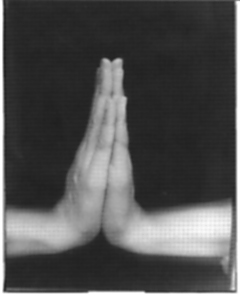
Most Western Buddhists were raised in one of the three Semitic religions: Judaism, Christianity, or Islam. All three of these hold prayer as their principal spiritual method. This left many of us with a bad case of prayerphobia. We turned to Buddhism for its meditation, its lofty philosophy, its colorful tantric yogas, and its zany Zen poetry.
Traditional Buddhists, however, do pray. Any visitor to the monasteries and meditation centers of Asia can testify to this. For example, in Dharamsala one may witness the Dalai Lama and his monks performing some ritual involving chanting, much of which could be classified as “prayer.” The same scene with different monk faces can be seen in Japan, Korea, or Sri Lanka.
Prayer in Buddhism, however, is quite different from prayer in the Three Bigs, allowing those of us with prayerphobia to live comfortably with it. Firstly, it is practiced somewhat tongue-in-cheek. That is to say, it only becomes a “Buddhist” practice when it is coupled with awareness of the void nature of the three circles: the person praying, the prayer itself, and the act of praying. All three of these lack true existence or self-nature—that is to say, they have no inherent value or status. When, for example, a Tibetan recites a prayer, he/she should simultaneously be holding awareness of the void nature of these three circles of prayer. Should he/she fail to do so, the practice is not Buddhist.
Secondly, prayer is not quintessential or central to Buddhism. All Buddhist practices fall within one of two categories: “root” and “branch.” Root practice includes the three higher trainings—ethics, meditation, and wisdom—and/or the six Bodhisattva perfections—generosity, discipline, gentleness, joyous energy, meditative focus, and wisdom. Prayer is not listed separately, for it plays a secondary and thus dispensable role, in the sense that one can achieve enlightenment without it.
What is the place of these prayers within the overall Buddhist structure? Essentially they belong to the type of peripheral meditation practice that is known in Tibetan as shargom, or “arousing meditation.” This contemplative method is defined as a process of arousing various thoughts in the mind and then briefly meditating on them. For example, one verse of a prayer by the Seventh Dalai Lama reads, “May I always view all living beings as having been a loving mother to me in a past lifetime, and always treat them with only love and respect.” These words are the launching ground for arousing a brief meditation on love and compassion.
According to those Buddhist lineages that descend from the doctrine of the Three Kayas, the mind of every being who achieves Buddhahood dissolves into and becomes of one flavor with the dharmakaya.This dharmakaya is formless, timeless, and is the very nature of infinity. However, only other Buddhas can perceive the dharmakaya aspect of those beings who have achieved enlightenment. Therefore the dharmakaya emanates firstly as samboghakaya, which can be perceived by aryas (i.e., saints), and secondly as nirmanakaya, which can be perceived by ordinary living beings of high merit.
For those Buddhist schools who do not embrace the doctrine of the Three Kayas, prayer is simply a method of collecting and focusing particular thoughts. They bring a mentalistic perspective to their practice.
For the ones who embrace the doctrine of the Three Kayas, however, the situation is more complex. Theirpranidana exercise will probably include a particular Buddha or Bodhisattva, an emanation of the universal Dharmakaya wisdom, and ostensibly an external entity. In addition to bringing the force of “arousing meditation” into the prayer, the practitioner anticipates communion with the universal forces of dharmakaya and bringing this secret universal power into the equation of personal transformation.
The Buddhist schools of India that taught the doctrine of the Three Kayas also taught the doctrine of nonduality, and of the lack of any concrete distance between subject and object. In this sense any Buddha or Bodhisattva is merely a symbol of the best of our own inner processes, and we are all universal beings in touch with the universal flow. For example, one may envision that one’s prayer is directed at Buddha Amitabha, and on one level Amitabha is conceived as an external being who resides in Sukhavati Paradise; but on another level all things are but names and labels imputed by our own mind, and Amitabha is only the force of distinguishing awareness and enlightened appreciation within ourselves. The prayer is the method of bringing microcosm and macrocosm into synchronicity.
A Daily Prayer
These stanzas, part of a prayer which Mullin uses daily, are based on a prayer by the Seventh Dalai Lama.
The marigolds blooming in the gardens,
Embellishing the entire estate,
To dust are reduced
When come winter’s piercing storms.
Now, while radiantly beautiful,
They should be offered to the objects of refuge.
One may cherish property and wealth
Gained by cunning means,
But one day all one’s possessions
Will fall to others’ hands.
Now, while I have power over them,
May I use them to benefit the world.
The river so sparklingly clear
Meanders lazily over the plains;
One day it will disappear,
Leaving behind not a drop of water.
Now, while it flows with strength,
It should be used to irrigate the fields.
They work, the various magical crafts
For harming others and benefiting oneself;
But one day these methods are forgotten
And even their names are lost to darkness.
Now, while my mind burns clear and strong,
May I meditate on the teachings vast and profound.
Nothing real stands
Behind an echoed sound; still,
When one’s voice unexpectedly echoes
In the stomach of a cave,
The mind jumps
With great strength.
Similarly this string of empty words
Has no final essence,
No ultimate power or meaning;
Yet maybe it will affect my mind,
Whose nature also
In illusion is bound.
Thank you for subscribing to Tricycle! As a nonprofit, we depend on readers like you to keep Buddhist teachings and practices widely available.